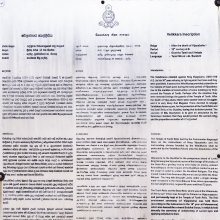Culavamsa, Cūlavaṃśa, Cūlavaṃsa, Culavamsha, Cūḷavaṃsa, Cula-vamsa, Cula-vamsha: 2 definitions
Introduction:
Culavamsa means something in Buddhism, Pali, the history of ancient India. If you want to know the exact meaning, history, etymology or English translation of this term then check out the descriptions on this page. Add your comment or reference to a book if you want to contribute to this summary article.
Images (photo gallery)
In Buddhism
Theravada (major branch of Buddhism)
Source: Pali Kanon: Pali Proper NamesA Pali chronicle of Ceylon. It is a continuation of the Mahavamsa, but, unlike the latter, is not a homogeneous work in that it was written by different authors at different periods. It is generally agreed that chapters thirty seven to seventy nine were written by the Thera Dhammakitti in the thirteenth century. The second section, beginning with the reign of Vijayabahu II. and ending with that of Parakkamabahu of Hatthiselapura (Chaps.80-90), seems to be the work of one author whose identity, however, remains unknown. That part of the chronicle which deals with the period from Parakkamabahu to A.C.1758, the death of Kittisiri Rajasiha, was compiled by Tibbotuvave Sumangala Thera, and the last chapter has been continued down to 1815 by Hikkaduve Siri Sumangala. For details see P.L.C.141ff.
Theravāda is a major branch of Buddhism having the the Pali canon (tipitaka) as their canonical literature, which includes the vinaya-pitaka (monastic rules), the sutta-pitaka (Buddhist sermons) and the abhidhamma-pitaka (philosophy and psychology).
India history and geography
Source: academia.edu: The Chronological History of Ancient Sri LankaCulavamsa or Chulavamsa gives the chronological history of Sri Lanka starting from King Siri Meghavahana (921-894 BCE), the son of Mahasena to King Sirivikramarajasimha (573-591 CE). According to Sri Lankan sources, the first part of Chulavamsa was composed by Thera Dhammakitti and the second part of Chulavamsa up to Kittisirirajasimha (525-560 CE) was composed by Tibbotuvave Siddhatta and the last chapter or supplement was added by Hikkaduve Siri Sumangala.

The history of India traces the identification of countries, villages, towns and other regions of India, as well as mythology, zoology, royal dynasties, rulers, tribes, local festivities and traditions and regional languages. Ancient India enjoyed religious freedom and encourages the path of Dharma, a concept common to Buddhism, Hinduism, and Jainism.
See also (Relevant definitions)
Partial matches: Vamsha, Cula.
Full-text (+7): Olanda, Navavamsa, Kannata, Samputa, Kotalla, Matularattha, Mahavamsa, Sangamuvihara, Viravikrama, Mandaligiri, Sangamu, Mandaligirivihara, Gangarohana Sutta, Simhagiri, Kesadhatuvamsa, Katakandhakara, Kalinganuvara, Gomati, Mandalagirika, Alagakkonara.
Relevant text
Search found 7 books and stories containing Culavamsa, Cūlavaṃśa, Cūlavaṃsa, Culavamsha, Cūḷavaṃsa, Cula-vamsa, Cula-vamsha, Cūḷa-vaṃsa, Cūla-vaṃśa, Cūla-vaṃsa; (plurals include: Culavamsas, Cūlavaṃśas, Cūlavaṃsas, Culavamshas, Cūḷavaṃsas, vamsas, vamshas, vaṃsas, vaṃśas). You can also click to the full overview containing English textual excerpts. Below are direct links for the most relevant articles:
Mahavamsa (by Wilhelm Geiger)
The Great Buddhist Emperors of Asia (by Shibani Dutta)
A Short history of Lanka (by Humphry William Codrington)
Visuddhimagga (the pah of purification) (by Ñāṇamoli Bhikkhu)
Dipavamsa (study) (by Sibani Barman)
The Catu-Bhanavara-Pali (critical study) (by Moumita Dutta Banik)
(9) Ratana sutta or Discourse on precious Jewels < [Chapter 2 - Subject Matter of the First Bhanavara]
